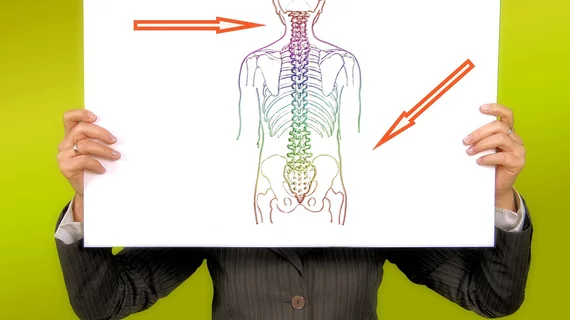Radiologists grab majority share of growing lumbar puncture market, with more on the horizon
Radiologists now deliver the lion’s share of lumbar puncture procedures among Medicare beneficiaries, with more opportunity on the horizon amid an aging U.S. population.
As recently as the early 1990s, rads’ share of the spinal tap market was as low as 10%. But a new Harvey L. Neiman Health Policy Institute analysis of the federal payment program pegged the number at 54% in 2017. During the 14-year study period, lumbar punctures per 100,000 Medicare beneficiaries leapt 25%, up to 203.4.
Study author Derek Johnson, MD, was surprised by the results; he always assumed neurologists were the go-to for lumbar punctures—a common procedure in which a needle is inserted into the spinal canal, sometimes guided by fluoroscopic imaging. Experts sees opportunity for imaging providers in these numbers.
“Radiologists are being asked to perform lumbar punctures in ever-increasing numbers,” Johnson, a neuroradiologist at the Mayo Clinic in Rochester, Minnesota, told Radiology Business Monday. “Even if the proportion of lumbar punctures performed by radiologists were to plateau now, the Medicare population is expected to increase markedly in the coming years, meaning that the absolute number of lumbar punctures performed by radiologists will almost undoubtedly increase.”
For the analysis—published this month in the American Journal of Neuroradiology—Johnson et al. analyzed Medicare claims logged between 2004 and 2017. They used a nationally representative sample to project across the payment program while also analyzing provider specialty, site of service, day of the week and patient complexity.
The numbers revealed that the portion of lumbar punctures performed by rads climbed from 37% in 2004 up to 54% by the study’s final year—a relative increase of 46%. Neurologists, meanwhile, saw their share fall from 24% down to 10% during the same time period, a relative decrease of 58%. Nonphysician providers had the largest relative increase, growing from 4% to nearly 8%.
Radiologists also remained the dominant provider in both inpatient and outpatient settings, while emergency medicine physicians rose to the top in the ED (80%). With the Medicare population projected to grow from 56 million last year up to 94 million by 2060, imaging providers should prepare to address this demand, the study authors asserted.
“Radiology practices must consider how they will meet this growing clinical need,” Johnson said. “For an individual radiology practice this may mean strengthening the infrastructure necessary to perform lumbar punctures, improving triage to identify patients with compelling indications for imaging-guided versus bedside lumbar punctures, or a combination of these measures.”

